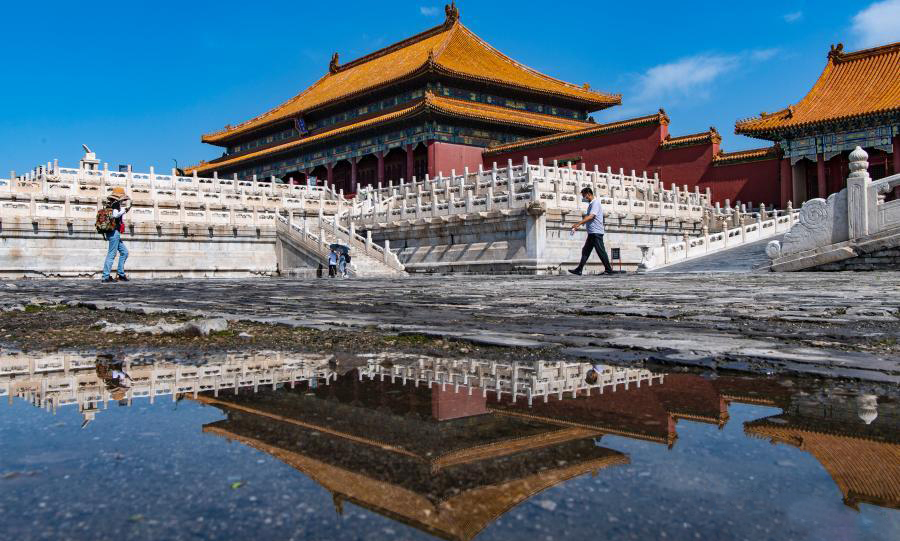Economy will speed up in second half year

LI MIN/CHINA DAILY
GDP growth slowed to 0.4 percent year-on-year in the second quarter of 2022, from 4.8 percent year-on-year in the first quarter. Yet the economy managed to avoid a contraction, despite the strict anti-pandemic measures, including lockdowns, to contain the sporadic COVID-19 outbreaks in many places in the country in April and May.
Our (Standard Chartered) calculations show China's economic output gap widened to-4.0 percent in the second quarter from-0.5 percent in the first quarter. Monthly data point to a continued economic recovery in June, as China eased COVID-19 restrictions due to declining new infections from May. Industrial production growth rebounded to 3.9 percent year-on-year in June from-2.9 percent year-on-year in April and 0.7 percent year-on-year in May, although the pace remained slower than 7.5 percent in January-February.
Fixed-asset investment growth improved to 5.8 percent year-on-year in June from 4.7 percent in May, led by a recovery in infrastructure investment (8.2 percent year-on-year versus 7.2 percent in May) and manufacturing investment growth (9.9 percent versus 7.1 percent prior).
Also, the impact of pandemic prevention and control measures on the services and retail sectors eased as well, with their growth rates recovering to 1.3 percent year-on-year and 3.1 percent year-on-year, respectively, in June (from-5.1 percent and-6.7 percent in May). Looking ahead, we expect China's economy to improve further in the run-up to the 20th National Congress of the Communist Party of China on increased stimulus and less disruptive anti-pandemic policies.
Better outlook in Q3, Q4, job market specially vital
We expect GDP growth of 5.3 percent year-on-year in the third quarter and 5.9 percent year-on-year in the fourth quarter, and maintain our call of no more changes to the medium-term lending facility (MLF) rate or the reserve requirement ratio (RRR) until the end of 2023.
While this year got off to a better-than-expected start, China's economy stumbled in the second quarter due to new sporadic COVID-19 outbreaks, domestic housing sector concerns, and global repercussions from the Russia-Ukraine conflict.
The economic slowdown particularly affected the youth labor market in the second quarter. According to official data, the youth (in the 16-24 age group) unemployment rate rose to 19.3 percent in June, despite an improvement in employment conditions for the 25-59 age group for a second month (with their unemployment rate declining from 5.3 percent in April to 4.5 percent in June).
We expect pressure on the youth labor market to rise further in July and August, with more than 10 million new college graduates about to enter the job market.
Urban household income and consumption expenditure were also hit in the second quarter. In nominal terms, urban household disposable income growth slowed to 1.5 percent year-on-year in the second quarter from 5.4 percent year-on-year in the first quarter and average growth of 5.8 percent in 2020-21. And urban household consumption expenditure declined 4.5 percent year-on-year in the second quarter, compared with 5.7 percent growth in the first quarter and average growth of 4.2 percent in 2020-21.
At the State Council meeting on July 13, Premier Li Keqiang said the government will strive to ensure that at least one person is employed in every family and to increase hiring of migrant workers in government-funded investment projects. The government has also warned against discrimination against those who have tested positive for COVID-19 but recovered, and pledged to increase policy support for more than 200 million people in flexible employment.
Consumer spending to further normalize
While we expect consumer spending to further normalize in the second half of the year on easing COVID-19 containment policies, the pace of recovery is likely to be tepid (rather than rapid).
Retail sales growth recovered to 3.1 percent year-on-year in June after falling a sharp 11.3 percent year-on-year in April and 6.7 percent in May. However, the pace of growth remained slow compared with growth of 6.7 percent in January-February and the pre-pandemic level of 8.1 percent in 2019.
With China's dynamic clearing policy likely to continue, mobility restrictions (even if less stringent) and the fear of contracting COVID-19 is expected to continue to weigh on the consumer market, with many people avoiding travel, shopping and dining out.
Falling household confidence and unwillingness to take on more debt are also likely to cap the consumer spending recovery in the near term.
According to the People's Bank of China, households' confidence in their future employment and incomes fell materially in the second quarter, with the share of people preferring to save more and invest less rising to 58.3 percent from 54.7 percent in the first quarter, while yearly household new loans fell 38 percent year-on-year in June compared with growth of 35 percent in March 2021. As a result, sales of big-ticket items continued to decline, with sales of housing floor space contracting 21.8 percent year-on-year in June, compared with-36.6 percent year-on-year in May and-42.4 percent year-on-year in April.
Housing demand remains weak
Housing demand remains weak despite easing policies, reflecting concerns about housing price declines and default risks of developers, as well as structural issues such as falling affordability and rapidly rising household debt.
Overall fixed-asset investment growth improved to 5.8 percent year-on-year in June from 4.7 percent in May, led by recovering infrastructure and manufacturing investment growth, to 8.2 percent year-on-year and 9.9 percent year-on-year, respectively. Real estate investment, in contrast, declined 9.7 percent year-on-year in June compared with-7.7 percent year-on-year in May. However, we expect infrastructure investment growth to accelerate further to 10-15 percent in the coming months on increased government support.
Both consumer price index (CPI) and producer price index (PPI) inflation came in marginally higher than market expectations in June, at 2.5 percent year-on-year and 6.1 percent year-on-year, respectively. And we expect CPI to trend higher through the first quarter of 2023 before base effects and slowing global demand likely take hold.
Underlying CPI inflation pressure seems entrenched, as both food and non-food inflation accelerated in June to 2.9 percent year-on-year and 2.5 percent year-on-year, respectively, from 2.3 percent and 2.1 percent in May. Food inflation will likely become a key inflation driver for China through the first half of 2023, led by higher pork prices.
The drivers of higher non-food CPI inflation in June were more broad-based, including continued pass-through of surging commodity costs to consumer goods; higher travelling and domestic services costs due to the easing of mobility restrictions in June; and higher fuel costs.
Headline PPI inflation eased to 6.1 percent year-on-year in June from 6.4 percent in May, and we expect it to ease further in the second half on base effects, slowing global economic growth and easing supply-chain pressures.
Nominal export growth accelerated to 17.9 percent year-on-year in June from 16.9 percent in May. High inflation, however, has masked a rapid slowdown in China's real export growth due to a softening global economy and a falling share of China in global total exports. International Monetary Fund data show China's yearly share of global exports fell to 14.3 percent in March from a peak of 14.8 percent in March 2021.
In real terms, China's export growth slowed to about 1.6 percent in the second quarter of 2022 from 10.4 percent year-on-year in the fourth quarter of 2021, while imports stayed weak, up only 1 percent year-on-year in June in nominal terms (versus 4.1 percent in May). China's real imports fell about 12 percent year-on-year in the first quarter.
The faster slowdown in imports pushed up China's trade surplus to $97.9 billion in June from $78.8 billion in May, lending support to the Chinese yuan against a strengthening US dollar. And the growth of M2 (amount of money in circulation in banknotes, coins, bank deposits and national savings accounts) picked up to 11.4 percent year-on-year in June from 11.1 percent in May, with new yuan loans jumping to 2.81 trillion yuan ($415.84 billion) in June, lifting outstanding loan growth by 0.2 percentage point to 11.2 percent year-on-year.
Second half growth likely to be 5.6%
Since the economic outlook of China's second quarter GDP growth (0.4 percent year-on-year) is in line with our forecast of 0.3 percent year-on-year, we maintain our GDP growth forecasts at 5.3 percent year-on-year for the third quarter, 5.9 percent year-on-year for the fourth quarter and an average of 5.6 percent in the second half of the year.
We also maintain our call of no more changes to the MLF rate or the RRR until the end of 2023. The window for further policy rate cuts has likely closed due to the increasingly hawkish stance of major central banks, an uptrend in China's CPI, and a likely economic recovery in the second half of 2022.
In the absence of policy rate cuts, the People's Bank of China is likely to increase the use of relending facilities and deposit rate reforms to adjust future credit growth and corporate borrowing costs.
We expect the government to fully implement or even overshoot this year's budget in order to maintain support for the economy amid continued COVID-19 disruptions and a slowing global economy. The planned broad budget deficit (including the general deficit, local special bonds and carryover funds) is equivalent to 6.9 percent of GDP in 2022, higher than the actual outcome of 5.2 percent in 2021.
A fully implemented budget should result in a fiscal impulse of 1.7 percent of GDP in 2022, lifting annual GDP growth by 0.9 percentage point. Looking forward, spending cuts are likely required in the second half, in our view, if the government aims to avoid breaching the annual broad deficit target of 6.9 percent of GDP.
Alternatively, if the government wants to maintain spending at the budgeted level, we estimate that 2.8 trillion yuan of additional funding is needed. The latter approach is more likely, in our view, based on recent official statements. The government may use the surplus cash accumulated in the past or advance the 2023 local special bond issuance quota to fill the revenue shortfall.
To fill the funding gap for infrastructure investment, the government has announced that it will issue 300 billion yuan of policy bank bonds and increase policy bank lending by 800 billion yuan this year. And media reports suggest that China may set up an infrastructure investment fund of 500 billion yuan and may allow local governments to issue some of next year's project bonds as early as in the fourth quarter of 2022.
Photos
Related Stories
- The resilience, potential of China's economy amid headwinds
- Western media should learn to put Chinese economy into perspective
- Factbox: Data highlights of Chinese economy on recovery track
- China's economy expected to improve amid supportive policies in H2: report
- Eurozone economies responding economic turbulence unevenly, raising challenges for ECB
Copyright © 2022 People's Daily Online. All Rights Reserved.









